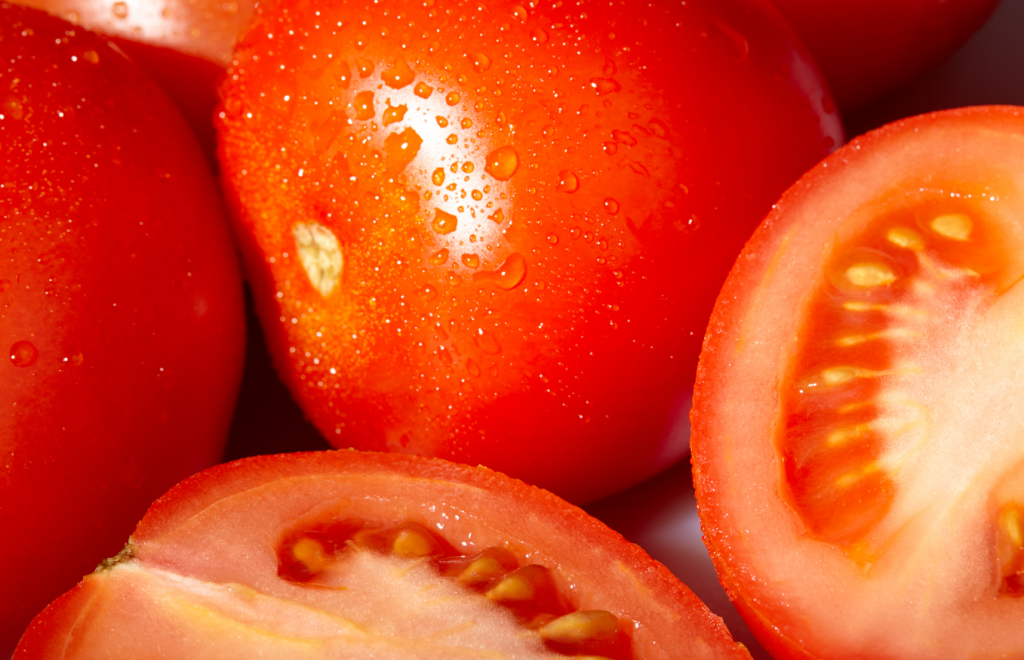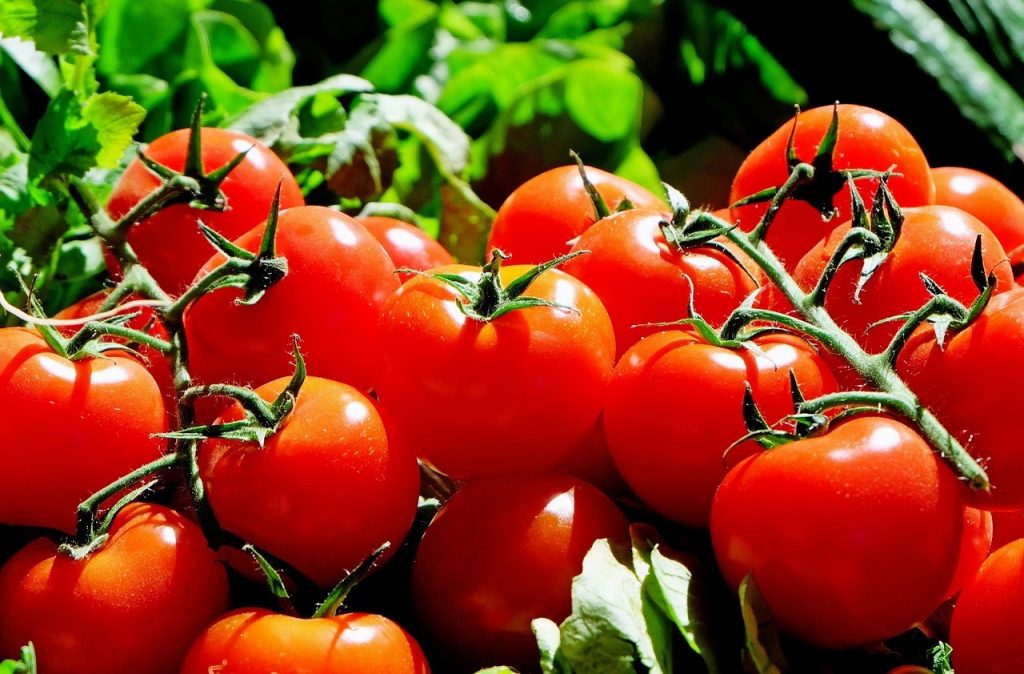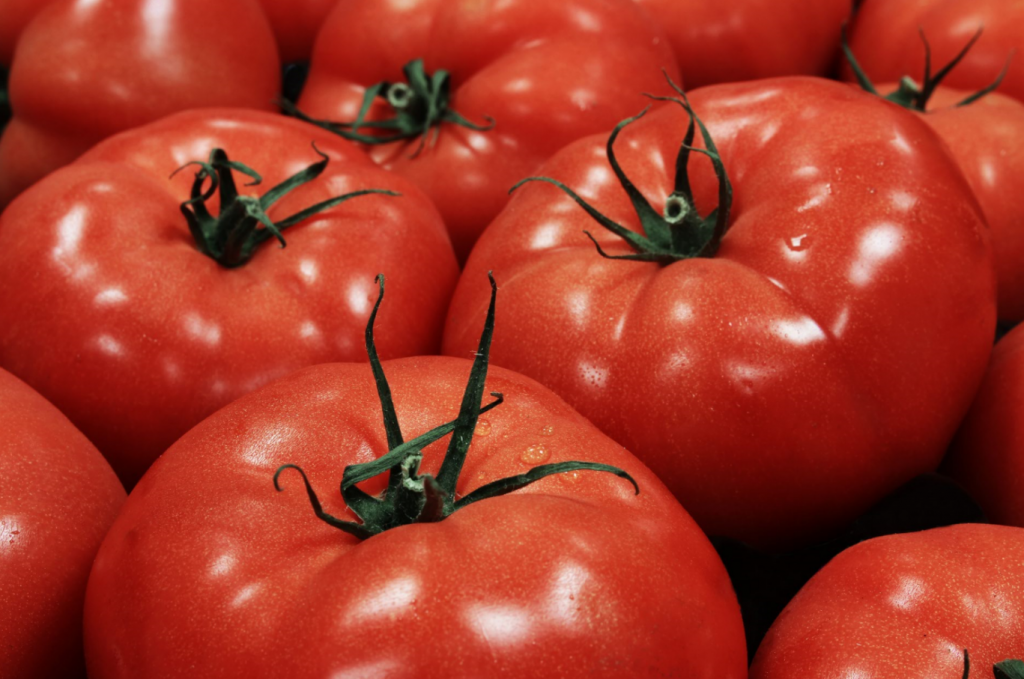Did you know?
The lycopene in processed tomatoes (canned, ketchup, sauce) is actually more available to the body than that found in raw tomatoes. Heating breaks down the plant’s cell walls, making the lycopene more accessible to the body. Lycopene is also better absorbed if consumed with a small amount of fat.

Although botanically classified as a fruit, the tomato is the most popular ‘vegetable’ grown in home gardens across America. The tomato plant is a warm-season perennial grown as an annual in summer gardens across the country. In Colorado, spring and fall cool temperatures allow tomatoes a short, but typically productive growing season. The texture, flavor, and cooking characteristics of tomatoes depend on the variety, growing method, handling techniques, and overall environment. As part of the Solanaceae family, also known as the nightshade family, tomatoes are relatives of peppers, potatoes, and eggplant.
Seasonality
In Colorado, tomatoes can be a challenge to grow due to the short growing season. The dry air and cool temperatures at night often prevent the pollination of certain varieties. However, tomatoes can be found at farmers’ markets from July-October, depending on the weather during the season. Nothing compares to a fully vine-ripened tomato; growing your own or purchasing them fresh from the market will produce the best flavor. Colorado also operates several large greenhouses used in the tomato industry, producing fresh tomatoes on a year-round basis.
Selection
Choose tomatoes with the following characteristics:
- Round, full, and heavy for their size
- Free from physical or insect damage
- Rich color, no bruising* or pitting
- Flesh yields slightly to gentle pressure
*Bruised tomatoes are good for making sauces. Bruised or “less perfect” tomatoes can often be purchased from a grower at a lower cost.
Handy Tip: Tomatoes harvested or purchased at 60-80% of their full color can be ripened in the kitchen. Ripening can be done in a paper bag with a few small holes punched into the side.
Handling
Foodborne illness outbreaks caused by Salmonella has been linked to the consumption of raw plum, Roma, round tomatoes, and items containing these raw tomatoes. Like any other fruit or vegetable, tomatoes can be contaminated by bacteria from the soil, water, animals, or human sources. Wash tomatoes well with clean water and dry with a paper towel before eating or preparing.
Storage
Whole tomatoes do not need to be stored in the refrigerator, as the flavor actually decreases upon chilling. Ripe tomatoes retain the best eating quality for 2 to 3 days, if stored at room temperature. Refrigeration does slow the ripening of tomatoes, so extra-ripe tomatoes may need to be refrigerated to keep the fruit from ripening any further. Always cover and refrigerate cut tomatoes.
Uses

Tomatoes can be used in a variety of ways; stewing, sautéing, grilling, or simply eating raw are common methods of preparation and serving. In addition, tomatoes can be frozen, dried, or canned.
Drying: Tomatoes that are dried using a dehydrator should be packed into an air-tight container and stored in the refrigerator. Dried tomatoes can be a great flavor addition to sauces, salads, or as an appetizer- but should be done using safe drying methods.
Freezing: Frozen tomatoes are best used in dishes such as soups, stews, or sauces. To freeze, wash tomatoes, remove the stems, and cut out the core. Leave the tomato whole or cut into quarters and place in a freezer bag, leaving 1/2 inch of head space.
Canning: Although tomatoes are considered a high acid food, some varieties have a pH greater than 4.6. Tomatoes must either be canned using a pressure canner or acidified using lemon juice or citric acid and processed in a boiling water bath.
Why do I need to be aware of pH when canning salsa?

Foods such as pickles or salsa need to have an acid added if they are to reach a pH level of 4.6 or lower to prevent microorganism growth and/or survival. Microorganisms such as Clostridium botulinum, the bacteria that causes botulism, can survive and grow in some foods at certain pH levels. Although tomatoes naturally have a low pH, adding other ingredients with higher pH values may make the product unsafe to eat. Adding lemon juice or citric acid to the recipe will lower the pH, making a safe canned product.
Roasted Corn and Tomato Quesadillas
Colorado Chef Dan Skay, Parkview Medical Center, Pueblo
- 3 cups roasted corn on the cob
- 3 cups tomatoes, diced
- 1/2 cup onion, diced
- 1/2 cup green bell pepper, diced
- 1 jalapeno pepper, minced
- Shredded Monterey Jack cheese
Roast corn on the cob until tender. Cut corn from the cob and place in a container with the diced tomatoes, onion, and peppers. Mix well. Season a clean hot griddle; butter or vegetable spray a 10-inch tortilla. Place the corn-tomato mixture evenly on top of the tortilla. Cover with shredded cheese. Place another tortilla atop the cheese and butter or vegetable spray the outside of the tortilla. When the bottom tortilla begins to turn golden, turn it over being careful not to lose the flavorful filling inside. When the bottom tortilla turns golden, remove, cut into 6 triangles and serve with fresh salsa.
Source: Colorado Proud
Nutrition

In addition to Vitamin C, Vitamin A, fiber, and potassium, tomatoes contain large amounts of lycopene. This compound may play a role in the prevention of certain types of cancer, particularly prostate cancer. Carotenoids, such as beta carotene and lycopene, are responsible for the bright red color seen in tomatoes, watermelon, and grapefruit. Through the process of cooking, lycopene becomes more available for use within the body. Using a small amount of healthy fats, such as olive oil, in a pasta sauce will enable the body to better metabolize lycopene, a fat soluble compound.


